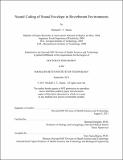| dc.contributor.advisor | Bertrand Delgutte. | en_US |
| dc.contributor.author | Slama, Michaël C. C. (Michaël Charles Chalom) | en_US |
| dc.contributor.other | Harvard University--MIT Division of Health Sciences and Technology. | en_US |
| dc.date.accessioned | 2012-01-12T19:29:24Z | |
| dc.date.available | 2012-01-12T19:29:24Z | |
| dc.date.copyright | 2011 | en_US |
| dc.date.issued | 2011 | en_US |
| dc.identifier.uri | http://hdl.handle.net/1721.1/68458 | |
| dc.description | Thesis (Ph. D.)--Harvard-MIT Division of Health Sciences and Technology, 2011. | en_US |
| dc.description | Cataloged from PDF version of thesis. | en_US |
| dc.description | Includes bibliographical references (p. 153-159). | en_US |
| dc.description.abstract | Speech reception depends critically on temporal modulations in the amplitude envelope of the speech signal. Reverberation encountered in everyday environments can substantially attenuate these modulations. To assess the effect of reverberation on the neural coding of amplitude envelope, we recorded from single units in the inferior colliculus (IC) of unanesthetized rabbit using sinusoidally amplitude modulated broadband noise stimuli presented in simulated anechoic and reverberant environments. Consistent with the attenuation of amplitude modulation (AM) in the stimulus, both rate and temporal coding of AM were degraded in IC neurons. However, in most neurons, the degradation in temporal coding was smaller than the degradation in the stimulus. In many neurons, this compensation could be accounted for by the modulation input-output function (MIOF), which describes the nonlinear transformation of modulation depth from the sound stimulus into the neural response. However, in a subset of neurons, the MIOF underestimated the strength of temporal coding, suggesting that reverberant stimuli may have a coding advantage over anechoic stimuli with the same modulation depth. Additional experiments suggest that interaural envelope disparities and interaural decorrelation introduced by reverberation may partly explain this coding advantage. In another set of experiments, we tested the hypothesis that temporal coding of AM is not static, but depends dynamically on the modulation depth statistics of preceding stimulation. In a subset of neurons, preceding stimulation history significantly altered the MIOF. On average, temporal coding of modulation frequency was more robust in conditions when low modulation depths predominate, as in reverberant environments. Overall, our results suggest that the auditory system may possess mechanisms for reverberation compensation, and point to an important role of binaural and dynamic neural processes for robust coding of AM in reverberant environments. | en_US |
| dc.description.statementofresponsibility | by Michaël C. C. Slama. | en_US |
| dc.format.extent | 159 p. | en_US |
| dc.language.iso | eng | en_US |
| dc.publisher | Massachusetts Institute of Technology | en_US |
| dc.rights | M.I.T. theses are protected by
copyright. They may be viewed from this source for any purpose, but
reproduction or distribution in any format is prohibited without written
permission. See provided URL for inquiries about permission. | en_US |
| dc.rights.uri | http://dspace.mit.edu/handle/1721.1/7582 | en_US |
| dc.subject | Harvard University--MIT Division of Health Sciences and Technology. | en_US |
| dc.title | Neural coding of sound envelope in reverberant environments | en_US |
| dc.type | Thesis | en_US |
| dc.description.degree | Ph.D. | en_US |
| dc.contributor.department | Harvard University--MIT Division of Health Sciences and Technology | |
| dc.identifier.oclc | 769129068 | en_US |
